Ceylon black tea, a tea lover’s gem, stands out with a unique taste and aroma.
It’s not as famous as some teas, but it’s a must-try.
But what does ceylon black tea taste like?
Ceylon tea taste is bold, brisk, and a bit citrusy, with a hint of honey or malt. It’s a tea with a full-bodied character and a pleasant, distinct fragrance.
It’s vibrant and can be both mild or strong, depending on the brew.
What about ceylon milk tea? And..
Flavor profile of different types of ceylon teas?
Fret not! I’m gonna cover everything in this guide!

What Does Ceylon Milk Tea Taste Like?
Ceylon Milk Tea has a strong, bold flavor.
It’s a black tea with milk, so it’s somewhat like a strong, milky black coffee.
The taste is a bit bitter and robust, similar to how dark chocolate can be.
The milk in Ceylon Milk Tea adds creaminess to the tea, making it smooth and rich.
It’s not too sweet, but you can add sugar to make it sweeter if you prefer.
The aroma of Ceylon Milk Tea is quite fragrant, with hints of the black tea’s earthiness and the sweetness of the milk.
It’s a bit smoky and toasty, which can be quite appealing.
When you take a sip, you’ll notice the strong tea flavor right away, followed by the velvety texture from the milk.
It’s not like your everyday tea; it’s got a distinctive taste that’s both bold and comforting.
Different Tastes of Ceylon Tea
Ceylon tea boasts not just one flavor – it’s a whole spectrum.
Here, I’ll talk about the different tasting notes you can find in Ceylon tea and why they make it so special.
-> Full-Bodied
Ceylon tea is known for its full-bodied taste.
This means it has a rich, robust flavor that can stand up to milk and sugar.
The reason behind this? It’s the low-grown tea.
The plants in the low elevations develop a hearty, bold taste due to the terroir and climate of the region.
-> Bright and Refreshing
Some Ceylon teas have a bright, crisp taste.
This is often found in high-grown teas.
The high altitude and cool climate give the tea leaves a vibrant, lively character.
-> Citrus Zest
Citrusy notes are another specialty of Ceylon tea.
You might catch a hint of lemon or orange in your sip.
This zesty flavor comes from the unique combination of tropical sunshine and fertile soil of Sri Lanka.
-> Astringency
Astringency is a distinct quality in some Ceylon teas.
It’s that slight dryness or puckering feeling in your mouth.
The astringency in Ceylon tea is due to the careful processing and oxidation of the leaves.
-> Floral and Delicate
For those who prefer a more delicate taste, Ceylon tea has something to offer as well.
Some high-grown varieties have a floral and light character.

What Does Ceylon Tea Smell Like?
Ceylon tea has a distinct, refreshing aroma that varies depending on the type and grade of tea.
When you open a pack or brew a cup of Ceylon tea, you might notice a crisp and invigorating scent.
It often carries a grassy or slightly woody undertone, which adds to its uniqueness.
The aroma of Ceylon tea is also influenced by the region in Sri Lanka where it’s grown.
High-grown teas, cultivated in the cool and mountainous areas, tend to have a bright, floral fragrance.
In contrast, low-grown teas from the warmer, lowland regions might have a more robust and malty aroma.
It’s like a hint of the environment in every whiff.
Some Ceylon teas may also exhibit citrusy notes, akin to a zesty lemon or orange scent.
This aroma can be particularly pronounced in teas from certain regions.
It’s as if nature adds a touch of fruitiness to your tea experience.
The freshness and quality of the tea leaves play a vital role in the aroma as well.
Well-preserved Ceylon tea tends to have a stronger and more inviting scent compared to tea that has been stored for a long time.
So, when you enjoy a cup of Ceylon tea, make sure it’s freshly stored to savor the full, enticing fragrance.
Why Does Ceylon Tea Taste So?
Ceylon tea tastes unique because of where it’s grown.
The island of Sri Lanka, formerly known as Ceylon, is the perfect place for tea.
The climate, soil, and altitude there create a one-of-a-kind flavor in the leaves.
The tropical climate with monsoons helps tea plants grow well.
They thrive in this weather and produce leaves with a distinct taste.
You might notice the freshness in every sip.
As I mentioned earlier, altitude plays a role too.
Tea estates in Sri Lanka are found on different elevations.
This impacts the taste.
High-grown teas are lighter and have a delicate taste, while low-grown teas are robust and full-bodied.
It’s all about the altitude magic.
The soil in Sri Lanka is rich in minerals.
The plants absorb these minerals, which gives Ceylon tea a unique character.
It’s a bit like how the food we eat influences our own flavor.
The different regions in Sri Lanka, each with its own terroir, contribute to the variety of Ceylon teas.
Whether it’s the high-grown tea from Nuwara Eliya or the bold, robust tea from Uva, there’s a Ceylon tea for every palate.
Finally, the way the tea is processed is crucial.
Ceylon tea is known for its briskness, brightness, and astringency.
These qualities come from the way the leaves are oxidized and fermented.
So, when you sip Ceylon tea, you’re tasting the sun, the rain, the altitude, and the soil of Sri Lanka.
High-grown, Mid-grown, & Low-grown Ceylon Teas Taste
Did you know that there are three main types of Ceylon teas? That’s right!
We have High-grown, Mid-grown and Low-grown Ceylon teas, each with its own taste profile.
-> High-grown Ceylon Teas
High-grown Ceylon teas are cultivated at elevated estates, at elevations of 4,000 to 7,000 feet above sea level.
At these heights, the tea plants enjoy cooler temperatures and crisp mountain air.
This unique environment encourages the leaves to grow slowly, developing a bright and brisk flavor.
You can taste the freshness of citrus notes and delicate florals in high-grown Ceylon teas, thanks to the clean mountain air and the gentle touch of the sun.
Examples of High-grown Ceylon Teas: Some famous high-grown Ceylon teas include Nuwara Eliya, Uva, and Dimbula.
These teas are perfect for those moments when you need a little pick-me-up.
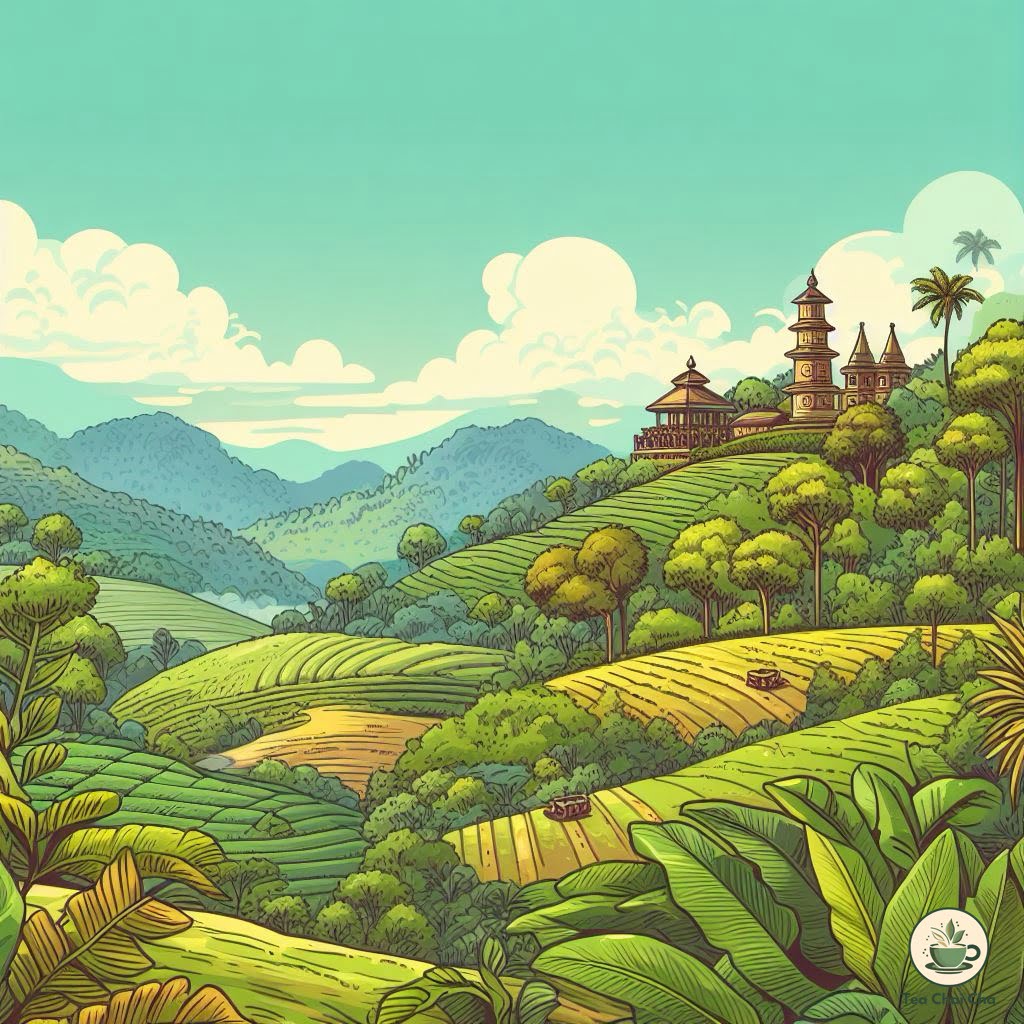
-> Mid-grown Ceylon Teas
Mid-grown Ceylon teas strike a balance between the uplifting qualities of high-grown teas and the robustness of low-grown teas.
These teas grow at elevations ranging from 2,000 to 4,000 feet above sea level.
They have a flavor profile that’s neither too brisk nor too bold.
Mid-grown Ceylon teas often have notes of fruitiness, a touch of spice, and a hint of floral sweetness.
When you sip a mid-grown Ceylon tea, you’ll often notice a combination of brightness and body.
The taste is smooth and satisfying, making it a great choice for any time of day.
Examples of Mid-grown Ceylon Teas: Popular mid-grown Ceylon teas include Kandy and Matale.
These teas are versatile and can be enjoyed on various occasions.
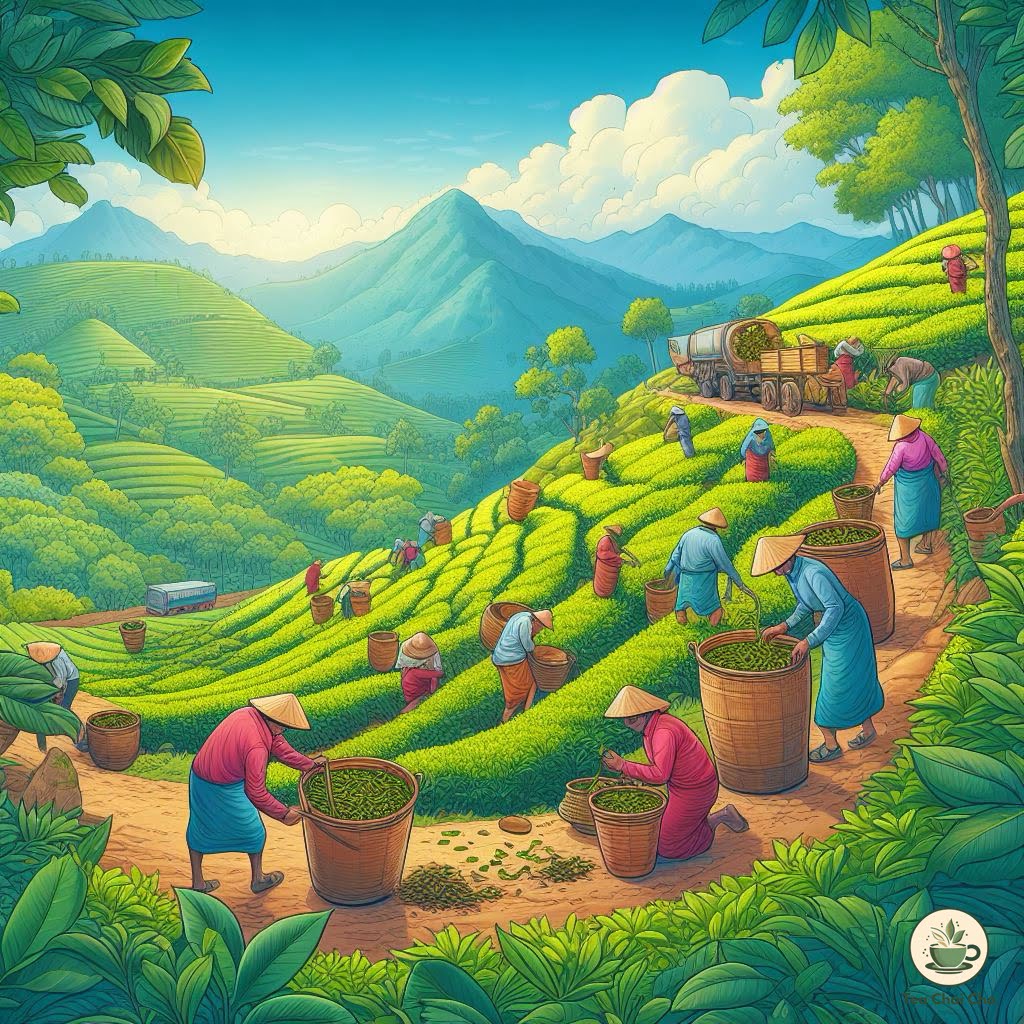
-> Low-grown Ceylon Teas
On the other hand, low-grown Ceylon teas thrive at lower elevations, typically between sea level and 2,000 feet, where the climate is warmer and more tropical.
The tea plants here receive plenty of sunshine and warmth, which results in a different taste experience.
The leaves from low-grown estates produce teas with a bold and malty character.
The tropical climate gives them a deep, full-bodied flavor, often accompanied by hints of caramel and even a touch of chocolate.
Examples of Low-grown Ceylon Teas: Well-known low-grown Ceylon teas include Ruhuna and Sabaragamuwa.
They’re perfect for those times when you need a tea that’s hearty and satisfying.
What Do Different Ceylon Teas Taste Like?
Ceylon teas come from Sri Lanka and are known for their unique flavors.
In this section, I’ll break down what different Ceylon teas taste like, so you can find your perfect cup.
-> Black Ceylon Tea
Black Ceylon tea has a bold and robust flavor.
It’s often described as full-bodied, with a hint of citrusy brightness.
If you enjoy a strong, brisk tea, this one might be your go-to choice.
-> Green Ceylon Tea
Green Ceylon tea is fresh and lively. It has a grassy and slightly vegetal taste.
If you prefer milder teas with a touch of astringency, this could be your cup of tea.
-> White Ceylon Tea
White Ceylon tea is the gentlest of the bunch.
It has a delicate, floral taste with a touch of sweetness.
If you’re into subtle and elegant flavors, white Ceylon tea is worth a try.
-> Oolong Ceylon Tea
Oolong Ceylon tea strikes a balance between black and green.
It’s semi-oxidized and has a smooth, fruity, and woody flavor.
If you’re looking for something in between, give oolong Ceylon tea a shot.
-> Herbal Ceylon Teas
Ceylon teas are also blended with various herbs and spices, creating a wide range of herbal teas.
These teas can have flavors like spicy, minty, floral, or fruity, depending on the ingredients.
Which Ceylon Tea Type Is Best for Who?
When it comes to Ceylon tea, there’s a wide variety to choose from.
The different types of Ceylon tea offer unique flavors and characteristics.
In this section, I’ll help you choose the best ceylon tea for your taste buds.
| Ceylon Tea Type | Flavor Profile | Best For |
|---|---|---|
| Assam Ceylon Blend | Bold, robust, malty | Those who prefer a strong tea. |
| Dimbula Ceylon | Smooth, mellow, citrusy, floral | Those who seek a gentler experience. |
| Uva Ceylon | Bright, citrusy, brisk | Individuals who enjoy zesty teas. |
| Nuwara Eliya Ceylon | Light, flowery, aromatic | Tea enthusiasts looking for subtlety. |
| Blend of Ceylon Teas | Balanced, versatile blend | Those who like a well-rounded cup. |
1. If You Prefer a Bold and Strong Flavor: Assam Ceylon Blend
Do you desire a robust and intense tea experience?
The Assam Ceylon blend might be your perfect choice.
This blend marries the boldness of Assam tea with the robust notes of Ceylon tea, delivering a full-bodied, brisk, and malty cup of tea.
It’s tailor-made for those who seek a robust and powerful tea flavor.
2. For a Smooth and Mellow Taste: Dimbula Ceylon
If you lean toward a gentler and mellower tea profile, Dimbula Ceylon tea is an excellent selection.
Hailing from Sri Lanka’s Dimbula region, it’s known for its harmonious flavor profile.
It offers a subtle yet intricate taste with hints of citrus and floral undertones.
Dimbula Ceylon is a soothing choice for those who prefer a more delicate tea experience.
3. Craving a Bright and Citrusy Tea? Go for Uva Ceylon
Uva Ceylon tea is renowned for its vibrant and citrusy flavor.
If you delight in the zesty and revitalizing essence of citrus in your tea, this is your ideal choice.
Grown at high altitudes, Uva teas possess a unique vibrancy and a refreshing, brisk quality.
It’s a superb option for those who seek a lively cup of tea.
4. If You Prefer a Light and Flowery Tea: Nuwara Eliya Ceylon
For tea aficionados who appreciate a gentle, floral, and aromatic infusion, Nuwara Eliya Ceylon tea stands out.
Grown in Sri Lanka’s Nuwara Eliya region, often referred to as the “Little England” of Sri Lanka, this tea features delicate floral notes with a touch of briskness.
It’s perfect for moments when you yearn for a subtle and fragrant tea experience.
5. When You Crave a Balanced Blend: Blend of Ceylon Teas
Sometimes, you may find that a well-balanced cup of tea, using the finest elements of various Ceylon teas, is your preference.
In such instances, consider exploring a blend of Ceylon teas.
These blends are expertly crafted to deliver a balanced flavor profile that caters to a broader spectrum of tastes.
How to Buy the Best Tasting Ceylon Tea
To ensure you get the most satisfying cup, pay attention to the following key aspects:
1. Tea Grade and Type
When selecting Ceylon tea, consider the grade and type.
For a robust and full-bodied flavor, choose “BOPF” (Broken Orange Pekoe Fannings) or “OP” (Orange Pekoe) grades.
These teas are often rich and bold, perfect for those who prefer strong flavors.
Example: If you like a strong morning cup, go for Ceylon OP tea for a brisk and hearty taste.
2. Origin Matters
As you know by now, Ceylon tea is cultivated in various regions across Sri Lanka, each offering unique flavor profiles.
Uva, Dimbula, and Nuwara Eliya are popular regions.
Uva teas are known for their brightness and briskness, while Dimbula teas have a mellow and well-balanced taste.
Example: If you enjoy a milder, well-balanced cup, explore teas from Dimbula.
3. Leaf Grade and Size
Ceylon teas come in various leaf sizes, such as BOP, FBOP, or SFTGFOP (Super Fine Tippy Golden Flowery Orange Pekoe).
Larger leaves often yield a smoother, less bitter taste, while smaller leaves can be more intense.
Example: To experience a smoother Ceylon tea, opt for a SFTGFOP grade.
4. Tea Estate and Quality
Research the tea estate’s reputation.
High-quality Ceylon teas often come from established estates with a history of producing exceptional tea.
Recognizable estates like Dilmah and Lumbini are known for their quality.
Example: For a trusted choice, select tea from the Dilmah estate.
5. Taste and Aroma Preferences
If you prefer a citrusy and bright flavor, look for teas with those descriptors.
For a more malty and robust taste, seek out teas known for those qualities.
Example: If you love citrus notes, search for Ceylon teas with “citrusy” in their flavor profile.

What Flavors Pair Well with Ceylon Tea – Sri Lankan Style!
Ceylon tea, known for its brisk and bold flavor, pairs exceptionally well with a variety of foods.
Sri Lankans, who are connoisseurs of this tea, have mastered the art of pairing it with dishes that enhance its taste.
Here are some classic combinations to heighten your tea-drinking experience.
-> Classic Tea-Time Sandwiches
When it comes to Ceylon tea, Sri Lankans know that classic tea-time sandwiches like cucumber, egg, or tomato are a perfect match.
These light and savory bites beautifully complement the tea’s brisk notes, making every bite a delightful experience.
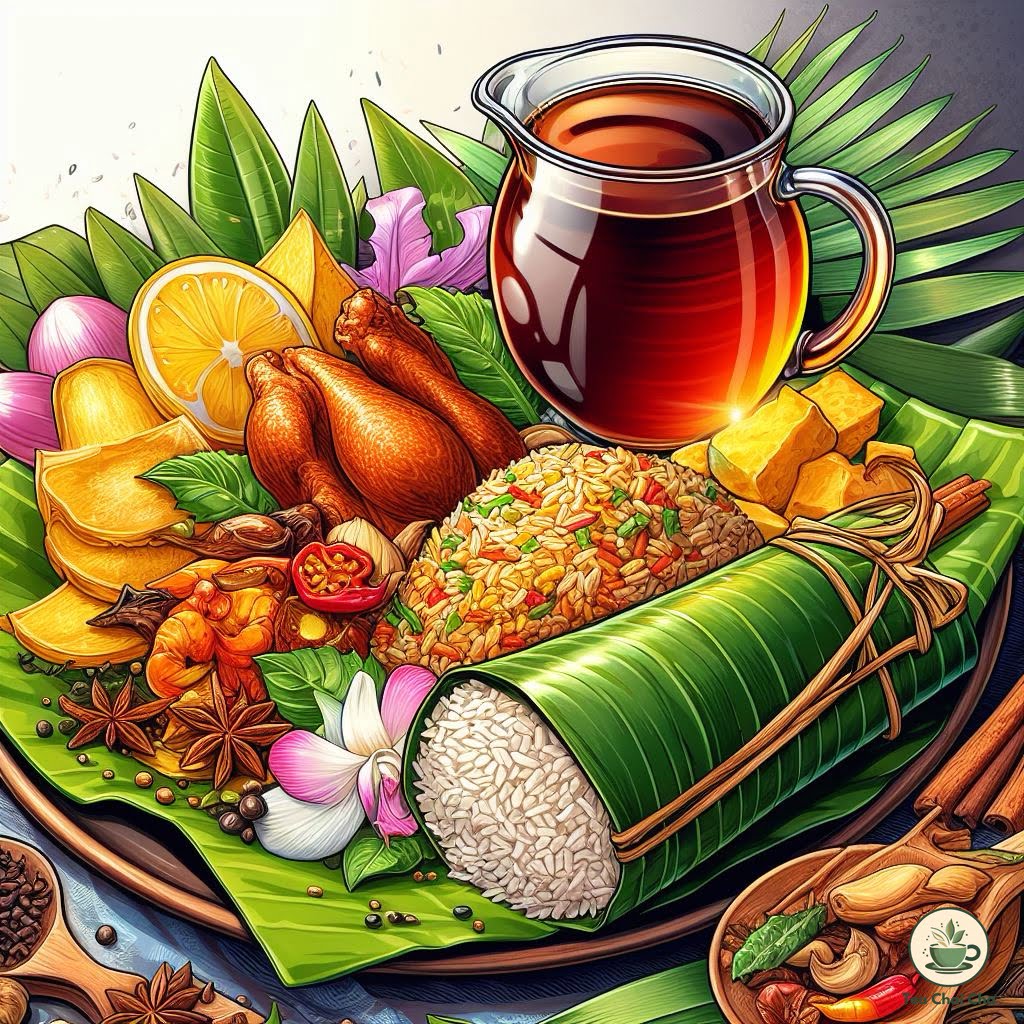
-> Lamprais
Lamprais, a beloved Sri Lankan dish, pairs remarkably well with Ceylon tea.
It’s a delightful combination of rice, meat (usually chicken or mutton), vegetables, and a range of spices, all wrapped in a banana leaf.
The tea’s boldness harmonizes with the complex flavors of the dish, making each mouthful a taste sensation.
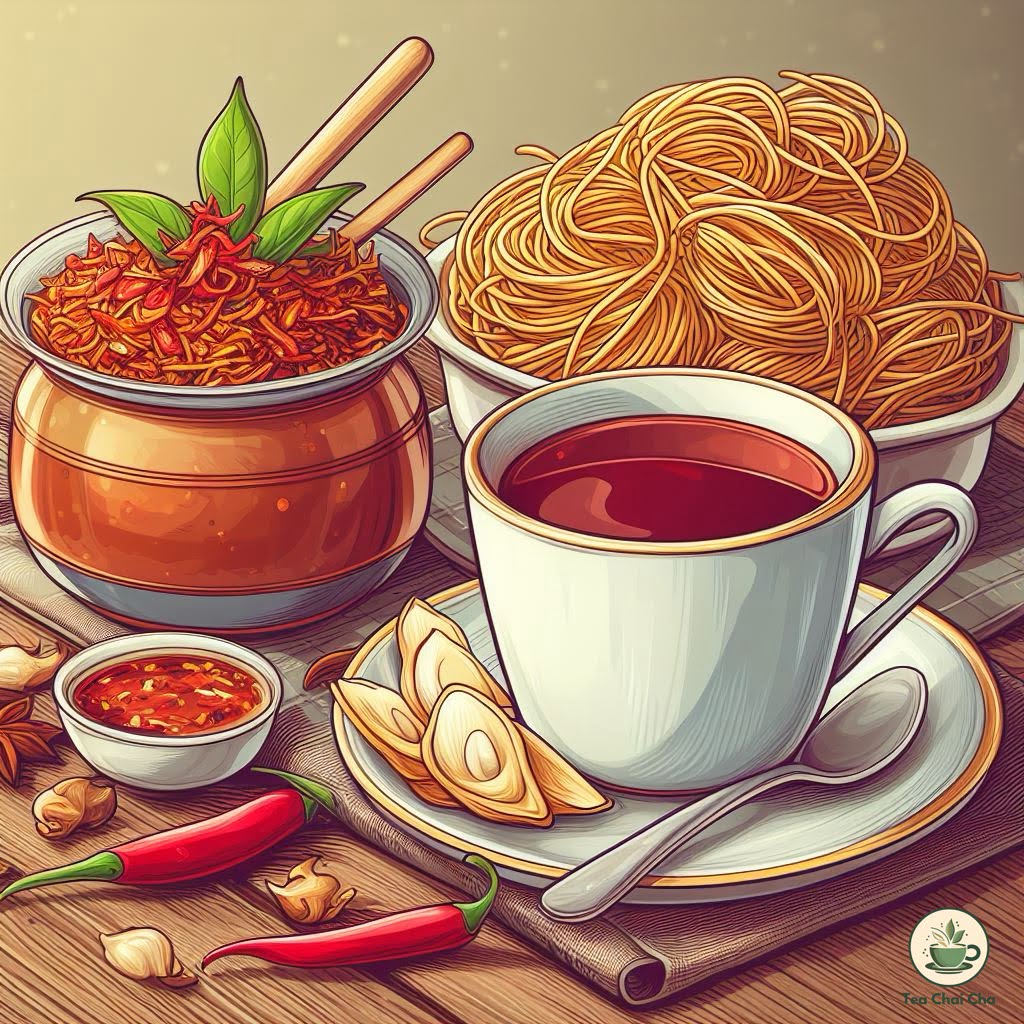
-> String Hoppers and Sambol
String hoppers, a traditional Sri Lankan dish made from rice noodles, and spicy sambol (a condiment made from chili, coconut, and various spices) are often enjoyed with Ceylon tea.
The spicy kick of sambol contrasts superbly with the tea’s brightness, creating an exciting taste experience.
-> Love for Watalappam
Watalappam, a rich and creamy Sri Lankan dessert made from coconut milk, jaggery, and spices, is a popular choice to enjoy alongside Ceylon tea.
The sweet, caramel-like flavor of Watalappam harmonizes with the tea’s astringency, creating a delightful balance of tastes.
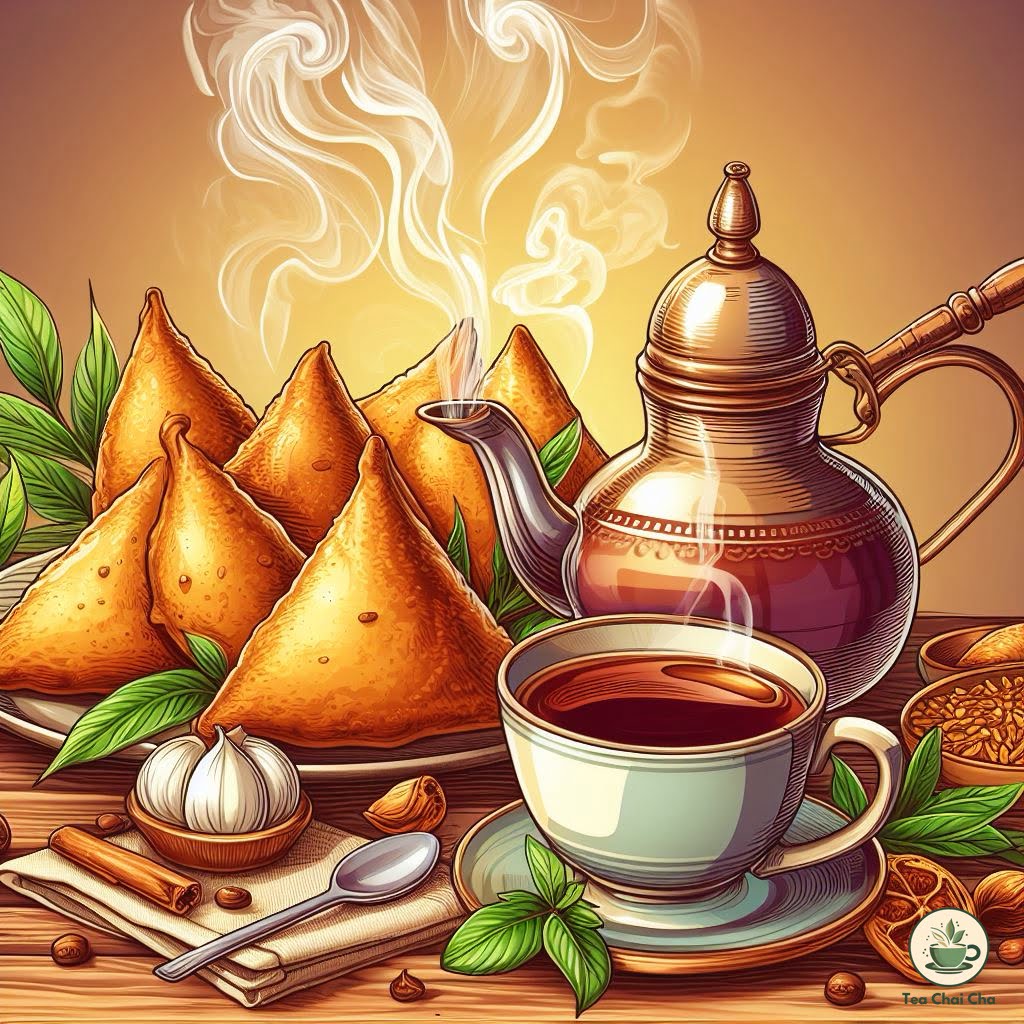
-> Samosas
Ceylon tea pairs perfectly with the spiciness of samosas, a popular snack not only in Sri Lanka but around the world.
These deep-fried pastries, filled with savory ingredients like potatoes, peas, and spices, complement the tea’s bold character with their flavorful, crunchy exterior.
5 Teas That Taste like Ceylon Tea
Wait, wait! I have something more for you!
If you’re a fan of Ceylon tea, you might want to explore these other tea options with similar taste profiles:
| Tea Type | Flavor Profile | Origin | Similar to Ceylon? |
|---|---|---|---|
| Kenyan Black Tea | Robust, malty, brisk | Kenya | Yes |
| Assam Tea | Strong, malty, brisk | India (Assam) | Yes |
| Darjeeling Tea | Delicate, floral (some versions are brisk) | India (Darjeeling) | Partially |
| Nilgiri Tea | Mild, brisk, citrusy | India (Nilgiri) | Partially |
| Yunnan Black Tea | Malty, robust, subtly sweet | China (Yunnan) | Partially |
1. Kenyan Black Tea
For a strong and brisk tea akin to Ceylon, try Kenyan black tea.
It has a bold flavor with malty notes, making it a great choice for Ceylon enthusiasts.
2. Assam Tea
Assam tea from India is known for its robust, malty, and brisk flavor.
It’s a close match to Ceylon in terms of strength and taste.
3. Darjeeling Tea
While typically delicate and floral, some second flush Darjeeling teas can have a stronger, more Ceylon-like flavor with briskness and astringency.
4. Nilgiri Tea
Nilgiri tea, from southern India, offers a mild yet brisk and citrusy experience.
Some Nilgiri teas can provide a Ceylon-like taste.
5. Yunnan Black Tea
Surprisingly, certain Yunnan black teas from China can resemble Ceylon with their malty, robust flavor and subtle sweetness.
Related Guides on Tea Taste
- What Does Assam Tea Taste Like? Try 5 Alternatives to Assam Tea!
- What Does Irish Breakfast Tea Taste Like? Dip in Before Sipin’!
- What Does Earl Grey Tea Taste Like? Lemony or Orangey Flavor?
- What Does English Breakfast Tea Taste Like? Is It Bold?
- What Does Darjeeling Tea Taste Like? 5 Teas With Similar Taste
Did this post help you learn about the unique flavor of Ceylon tea in depth? Lemme know below!
